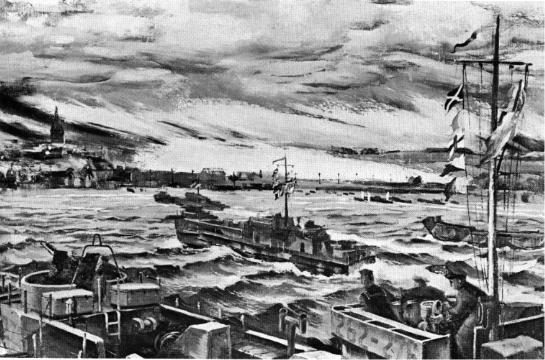THE RCN ON D-DAY
Originally
published in the "Crowsnest Magazine" Vol. 16 No. 5 May
1964
By Lt. Peter Ward, RCNR
|
|
|
|
|
IN EARLY JUNE the beach at Courseulles warms with the sun after dawn. Tents of holidaying Frenchmen make colourful splashes on the warm, golden-brown sand and a few young girls sprawl on blankets, skirts hiked high so spring sunshine can toast slim legs.
Eastward, the sea sweeps in a shallow five-mile horseshoe, with the town of Bernières-sur-Mer perched on a distant point. The line of beach houses at Bernières, daubed blue, red, white, and yellow, makes a misty rainbow splash through the lazy haze.
This five miles of beach is dotted with crumbling concrete pill boxes. At low tide the remains of tank traps and landing craft obstacles jut from tidal pools. A few minutes sifting through the sand anywhere will produce oddments of rusted barbed wire, brass bullet casings, or a jagged shell splinter. These are fragments of 20 years ago, testimony of the greatest invasion ever launched.
Canadian troops landed between Courseulles and Bernières-sur-Mer. They formed just a small fraction of the front opened by Allied forces June 6, 1944. Military historians are still trying to sort out the details of what happened that day.
Preliminary planning for the world’s largest amphibious operation began in May 1942. A small group of officers was assigned to study the problems involved in opening the second front by invasion across the Channel.
A year
later the tempo of activities increased and the staff expanded.
In early 1944 problem after problem was attacked, and solved. The
hour of D-Day grew nearer, the staff grew even bigger and details
became even more minute. This was the biggest planning job military
forces had ever attempted.
The Royal Canadian Navy felt the added load of the build-up for invasion months ahead of time. Convoy traffic increased across the Atlantic, crowding U.K. ports with transports. Cargoes that successfully ran the U-boat gauntlet added to the huge arsenal in the British Isles needed to launch Operation Overlord.
>>> Go to Next Page
 |
|
Lt.
Tom Wood's graphic painting of Canadian landing craft carrying
the Queen's Own Rifles onto the beach at Bernieres-sur-Mer.
(52)
|
